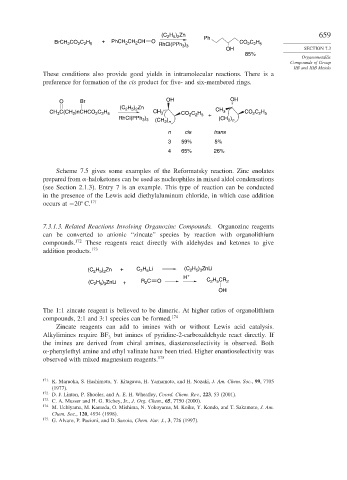Page 684 - Advanced Organic Chemistry Part B - Reactions & Synthesis
P. 684
(C H ) Zn Ph 659
2 5 2
BrCH CO C H + PhCH CH CH O RhCl(PPh ) CO C H
2
2
2 2 5
2
2 2 5
3 3
OH SECTION 7.3
85%
Organometallic
Compounds of Group
IIB and IIIB Metals
These conditions also provide good yields in intramolecular reactions. There is a
preference for formation of the cis product for five- and six-membered rings.
O Br OH OH
H ) Zn
(C 2 5 2 CH
CH C(CH )nCHCO C H CH 3 CO C H 3 CO C H
2 2 5
3
2
2 2 5
2 2 5 +
)
RhCl(PPh 3 3 (CH ) (CH )
2 n
2 n
n cis trans
3 59% 5%
4 65% 26%
Scheme 7.5 gives some examples of the Reformatsky reaction. Zinc enolates
prepared from
-haloketones can be used as nucleophiles in mixed aldol condensations
(see Section 2.1.3). Entry 7 is an example. This type of reaction can be conducted
in the presence of the Lewis acid diethylaluminum chloride, in which case addition
occurs at −20 C. 171
7.3.1.3. Related Reactions Involving Organozinc Compounds. Organozinc reagents
can be converted to anionic “zincate” species by reaction with organolithium
compounds. 172 These reagents react directly with aldehydes and ketones to give
addition products. 173
H Li
(C H ) Zn + C 2 5 (C H ) ZnLi
2 5 3
2 5 2
H + C H CR
H ) ZnLi
2
(C 2 5 3 + R C O 2 5 2
OH
The 1:1 zincate reagent is believed to be dimeric. At higher ratios of organolithium
compounds, 2:1 and 3:1 species can be formed. 174
Zincate reagents can add to imines with or without Lewis acid catalysis.
Alkylimines require BF but imines of pyridine-2-carboxaldehyde react directly. If
3
the imines are derived from chiral amines, diastereoselectivity is observed. Both
-phenylethyl amine and ethyl valinate have been tried. Higher enantioselectivity was
observed with mixed magnesium reagents. 175
171 K. Maruoka, S. Hashimoto, Y. Kitagawa, H. Yamamoto, and H. Nozaki, J. Am. Chem. Soc., 99, 7705
(1977).
172
D. J. Linton, P. Shooler, and A. E. H. Wheatley, Coord. Chem. Rev., 223, 53 (2001).
173 C. A. Musser and H. G. Richey, Jr., J. Org. Chem., 65, 7750 (2000).
174 M. Uchiyama, M. Kameda, O. Mishima, N. Yokoyama, M. Koike, Y. Kondo, and T. Sakamoto, J. Am.
Chem. Soc., 120, 4934 (1998).
175
G. Alvaro, P. Pacioni, and D. Savoia, Chem. Eur. J., 3, 726 (1997).

